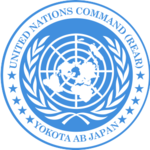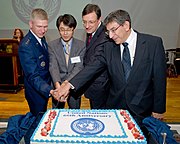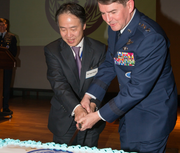United Nations Command–Rear
| UN Command–Rear | |
|---|---|
 Group Captain Luke Stoodley of the Royal Australian Air Force as United Nations Command–Rear commander, 2019 | |
| Founded | 1957 |
| Countries | Australia, Canada, France, Italy, Japan, New Zealand, Philippines, Thailand, Turkey, United Kingdom, and United States. |
| Allegiance | |
| Type | Command staff |
| Role | Liaison, protocol |
| Size | 5 |
| Part of | United Nations Command |
| Headquarters | Yokota Air Base |
| Colors | United Nations blue |
| Anniversaries | July 1, 1957 (activation)[1] |
| Website | United Nations Command–Rear |
| Commanders | |
| Commander | Royal Australian Air Force |
| Deputy Commander | Royal Canadian Air Force |
| NCO in charge[2] | United States Army |
| Insignia | |
| Identification symbol |  |
United Nations Command–Rear (also known as UN Command–Rear[4] or UNC–Rear[5]) is a military command headquartered in Japan, and a subordinate element of United Nations Command. UN Command–Rear was established in 1957 as a result of the relocation of UN Command from Japan to South Korea following the Korean War. It is in control of the rear elements the United Nations Command.
History
Background
The defeat of Japan in World War II led to the collapse of the Government of Korea under Japanese rule and the territorial bifurcation of the Korean Peninsula between the Pyongyang-based and Soviet-backed Democratic People's Republic of Korea (North Korea) and the Seoul-headquartered and United States-supported Republic of Korea (South Korea).[6][7]
On June 12, 1950, the South Korean Army informed the United States' Korean Military Advisory Group to the Republic of Korea that North Korea's Korean People's Army (KPA) was massing for an invasion.[8] Approximately two weeks later, according to the United States and South Korea, the KPA staged a surprise assault against South Korean military positions along the border, easily overwhelming the South's defenses.[8] North Korea advanced the alternate explanation that the entry of its forces into South Korea was done for the purposes of arresting Syngman Rhee due to what it claimed was a preemptive South Korean incursion that had taken place near Haeju.[8] The ensuing conflagration sparked the Korean War between North and South Korea and their respective allies and patrons.[7]
Following the outbreak of hostilities, the United Nations Security Council voted to authorize armed intervention on the side of South Korea.[9] The United States agreed to be named "executive agent" of the United Nations and, subsequently, formed United Nations Command.[9] UN Command, under General Douglas MacArthur and his wartime successors, oversaw military operations on the Korean Peninsula from headquarters in Japan.[10]
Formation

Active hostilities concluded in 1953 and UN Command relocated from Japan to South Korea four years later.[10][11] A 1954 Status of Forces Agreement (SOFA) was signed between the United Nations Command with Japan.[12][5]
Upon formation of UN Command–Rear, it was decided that it should be placed under an officer who was not American.[13] From 1957 to 1976, Thailand supplied an officer to UN Command–Rear, following which command responsibilities were assumed by the United Kingdom for two years.[13] From 1978 until at least 1987, the Philippines provided an officer to lead UN Command Rear.[13] Since 2010, Australia has made an officer available to the United States to be placed in command of UN Command–Rear.[14][15]
In 2007, UN Command–Rear relocated from its longtime headquarters at Camp Zama to Yokota Air Base.[16]
Operations
Authority
According to the Australian Defence Force Journal, UNC–R performs "certain administrative, support and liaison functions of a diplomatic type".[13] Specifically, United Nations Command–Rear nominally has joint authority, with the United States, over seven UN-flagged bases in Japan: Camp Zama, Yokota Air Base, Yokosuka Naval Base, Sasebo Naval Base, Kadena Air Base, White Beach Naval Facility, and Marine Corps Air Station Futenma.[17] In practice, all facilities are under the operational control of the United States.[18]
UN Command–Rear is also charged with providing legal notice to Japan regarding the entry of military forces from any of the nine SOFA co-signer states into Japanese territory, specifically, those of the United States, United Kingdom, Philippines, Australia, Canada, France, New Zealand, Turkey, and Thailand.[19] Under the SOFA agreement, the movement of signatory state military forces into Japan can occur with or without Japanese approval.[19] The agreement does require that a courtesy notice be provided to the Japanese government in advance of the entry of military forces into the country except in exigent circumstances in which case military forces can enter Japan without advance notification being given to the Japanese government.[19][12]
Personnel
As of 2021, United Nations Command–Rear had a strength of five personnel, but the number can increase during an emergency situation.[20]
According to Roger Chiasson, a former Canadian military officer who served as deputy commander of UN Command–Rear, his duties were "anything but onerous" and allowed him to live "a life of great privilege" during his assignment as second-in-command of the four-person unit, including access to various United States government-owned golf courses, stores, and a private hotel in downtown Tokyo.[21]
Gallery
- Yasuhiro Kobe (second from left), deputy director of the North American Affairs Bureau of the Japanese foreign ministry, representing Japan during the 2011 UN Command–Rear cake reception in celebration of United Nations Day
- U.S. Air Force General Jan-Marc Jouas and Koji Tomita (left), director of the North American Affairs Bureau of the Japanese foreign ministry, cutting the cake at the UN Command–Rear United Nations Day party in 2013
- UN Command–Rear commanding officer Group Captain Barbara Courtney greets a delegation from the Royal Thai Air Force at the Yokota Air Base in 2014
- Japanese Vice-Minister for Foreign Affairs Shunsuke Takei (left) cutting the cake with U.S. Army General Vincent K. Brooks during the 2016 UN Command–Rear United Nations Day party
- UNC and UNC-R officers pictured during a 2018 UNC-R change of command ceremony. In the background are the flags of the United States, Japan, Australia, United Nations, as well as General Brooks' position standard.
- General Brooks, as commander of the UN Command, gives Royal Australian Air Force Group Captain Adam Williams command of UN Command–Rear in 2018
See also
References
- ^ Perry, Charles. "The U.S.–Japan Alliance" (PDF). Institute for Foreign Policy Analysis. Tufts University. Archived (PDF) from the original on December 10, 2018. Retrieved March 26, 2018.
- ^ a b c d "United Nations Command–Rear". Yokota Air Base. United States Air Force. Archived from the original on December 10, 2018. Retrieved December 9, 2018.
- ^ "UNCR Change of Command ceremony". Stars & Stripes. January 31, 2018. Archived from the original on December 10, 2018. Retrieved March 26, 2018.
- ^ "Bringing up the rear: US bases in Japan support UN Command in S. Korea". Stars and Stripes. Retrieved 2024-05-01.
- ^ a b Bosack, Michael (February 1, 2018). "Relevance Despite Obscurity: Japan and UN Command". Tokyo Review. Archived from the original on March 27, 2018. Retrieved March 26, 2018.
The UN-Japan SOFA mandates that the signatories must execute five responsibilities. First, UNC must maintain a presence in Japan, which UNC–Rear accomplishes with its headquarters at Yokota Air Base. Second, it must be a multinational force; i.e. staffed by members from multiple foreign militaries. To that end, UNC–Rear currently sources its commander from the Royal Australian Air Force and deputy from the Royal Canadian Air Force, but has also included members from Thailand, the Philippines, and other nations in the past. Third, UNC and Japan must mutually designate bases for UNC use and (fourth) those bases must fly the UN flag. Those requirements are fulfilled throughout Japan at the seven designated bases.
- ^ Lee, Ki-baik. "Korea". britannica.com. Encyclopedia Britannica. Archived from the original on April 28, 2014. Retrieved February 9, 2019.
- ^ a b Hickey, Michael. "The Korean War: An Overview". bbc.co.uk. BBC News. Archived from the original on February 5, 2009. Retrieved February 9, 2019.
- ^ a b c Appleman, Roy (1992). South to the Naktong, North to the Yalu. Washington, D.C.: Center of Military History. pp. 20–21. ISBN 0-16-035958-9. Archived from the original on 2021-01-19. Retrieved 2019-02-09.
- ^ a b "United Nations Command". usfk.mil. United States Forces Korea. Archived from the original on December 10, 2018. Retrieved March 26, 2018.
The invading hordes breached the 38th parallel and rolled back the lightly-armed Republic of Korea Army constabulary forces toward their capital of Seoul. Two days later, the United Nations called on the countries of the world to unite and assist in driving the invader from the ROK. In its resolution, the UN Security Council named the United States as executive agent to implement the resolution and direct UN military operations in Korea.
- ^ a b Hoare, James (2015). Historical Dictionary of the Republic of Korea. Rowman & Littlefield. p. xxxix. ISBN 978-0810870932.
- ^ Lee, Dong-jun (March 2012). "From the Secret "Korean Minute" to the Open "Korea Clause": The United States and Japan and the Security of the Republic of Korea". Asian Perspective. 36 (1): 123–145. doi:10.1353/apr.2012.0004. JSTOR 42704783.
- ^ a b "Agreement regarding the Status of the United Nations Forces in Japan" (PDF). Foreign and Commonwealth Office. Her Majesty's Stationery Office. Archived (PDF) from the original on December 10, 2018. Retrieved March 26, 2018.
Appropriate notification in paragraph 3 means, under normal conditions, notification prior to entry. In cases of emergency or where security is involved , notification may be given subsequently to entry.
- ^ a b c d Degville, Lianne (July 1987). "United Nations Forces in Northeast Asia United Nations Command and United Nations Command (Rear) Their Missions, Command Structures and Roles in Regional Security" (PDF). Australian Defence Force Journal. Government of Australia. Archived (PDF) from the original on March 27, 2018. Retrieved March 26, 2018.
- ^ Dennett, Harley (August 29, 2017). "Aussie commander stands between North Korea and Japan". The Mandarin. Archived from the original on December 10, 2018. Retrieved March 26, 2018.
- ^ "Fourth Australian in role" (PDF). Air Force. Royal Australian Air Force. February 2016. Archived (PDF) from the original on October 17, 2016. Retrieved January 7, 2019.
- ^ "UNC celebrates the 67th Anniversary of the United Nations in Japan". U.S. Air Force. United States Government. Archived from the original on December 10, 2018. Retrieved March 26, 2018.
- ^ United Nations Command–Rear Fact Sheet (PDF). United Nations Command-Rear. pp. 1–2. Archived (PDF) from the original on December 10, 2018. Retrieved March 26, 2018.
- ^ Park, Won Gon (December 2009). "The United Nations Command in Korea: past, present, and future". Korean Journal of Defense Analysis. 21 (4): 485–499. doi:10.1080/10163270903298959.
- ^ a b c McCormack, Tony (2014). Air Power in Disaster Relief (PDF). Royal Australian Air Force. Archived (PDF) from the original on December 10, 2018. Retrieved March 27, 2018.
...the Government of Japan must be notified of any movement of these forces. This is an important point because if we are undertaking a UN operation, we do not need approval from the Government of Japan. We just have to notify them that we are coming in or going through the area. To use the SOFA you must be a signatory and the SOFA must be exercised regularly.
- ^ "Bringing up the rear: US bases in Japan support UN Command in S. Korea".
- ^ Chiasson, Roger (2018). Cape Bretoner at Large: From New Waterford to Tokyo and Beyond. FriesenPress. pp. 207–209. ISBN 978-1525512223.







